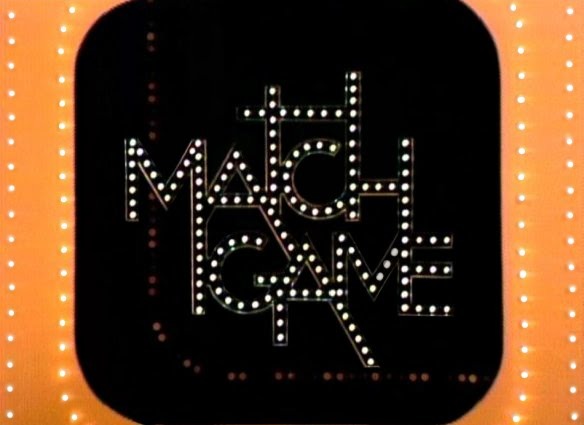

Now is the time of year that residents are starting to interview at programs across the U.S. in preparation for the NRMP Specialty Match and the hopeful placement in their top fellowship program (here at GeriPal, we are still hopeful that Palliative Medicine will soon enter the match, but the good news is that geriatrics is now fully in). One of the most important aspects of the match is that everyone understands the ground rules, the most important of which is to always submit your true preferences for programs/applicants when you fill out your Rank Order List. Residents applying to fellowships should be told this golden rule, as breaking it will NEVER be in their best interest. To learn why this is true, try playing the following game to learn how NRPM matches residents to programs.
RULES OF THE GAME
A. Each resident can only be accepted into one program.
B. For the purposes of simplicity, every program in this game has only 1 fellowship position available (in real life you may have more than one fellowship position)
C. Your job is to act as the NRMP matching algorithm by following these 4 steps:
- Start off by proposing a Resident to her top-ranked program based on her rank order list (ROL).
- The program accepts the proposal if it has an open spot, retaining the right to reject it later in the algorithm if a better suitor arrives.
- If the proposal is rejected, propose the Resident to the next program on her list.
- If the proposal is accepted, repeat the process for the next Resident B.
There is some more complexity in the system (mainly from couples matching), but this is basically what the Matching algorithm does in several milliseconds. So, lets play the matching game. Can you get all of the questions right?
QUESTION 1
There are two residents, two programs, and all put their true preferences in the Rank Order List (ROL) of the Match as outlined below:

What is the final match result?
Answer:
- Start with Resident 1 by proposing to program A, which is tentatively accepted as a match
- Go to Resident 2. Propose to program A, which is rejected, as Resident 1 is ranked higher
- Resident 2 Proposes to Program B, which is tentatively accepted as a match
- Final Match Result: Resident 1 – Program A; Resident 2 – Program B
QUESTION 2
Same example as question 1, with two residents and two programs. However, Resident 1 likes program A better but doesn’t think she can get in, so ranks B higher (so she doesn’t follow her true preferences, but believes it better serves her to rank the less preferred program higher)
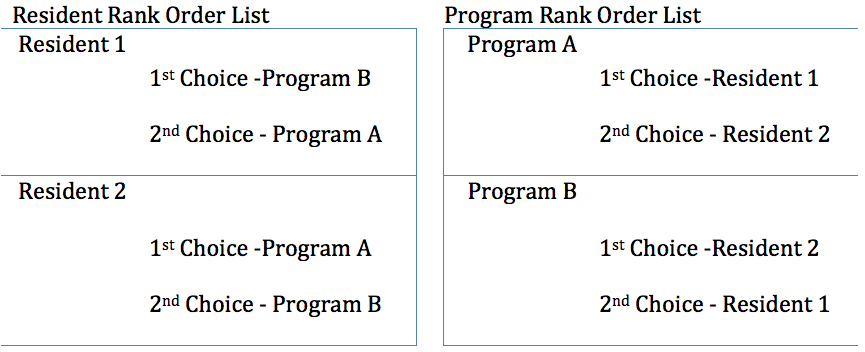
What is the final match result?
Answer:
- Start with Resident 1 by proposing to program B, which is tentatively accepted
- Go to Resident 2. Propose to program A, which is tentatively accepted
- Final Match Result: Resident 1 – Program B; Resident 2 – Program A
Take Home Point: Residents should always order their rank list based ONLY on their own preferences. Resident 1 would have been accepted to program A if she ranked it higher than program B
QUESTION 3 (getting tougher)
There are three residents, three programs, and all put their true rank order list (ROL) preferences as stated in the following picture:
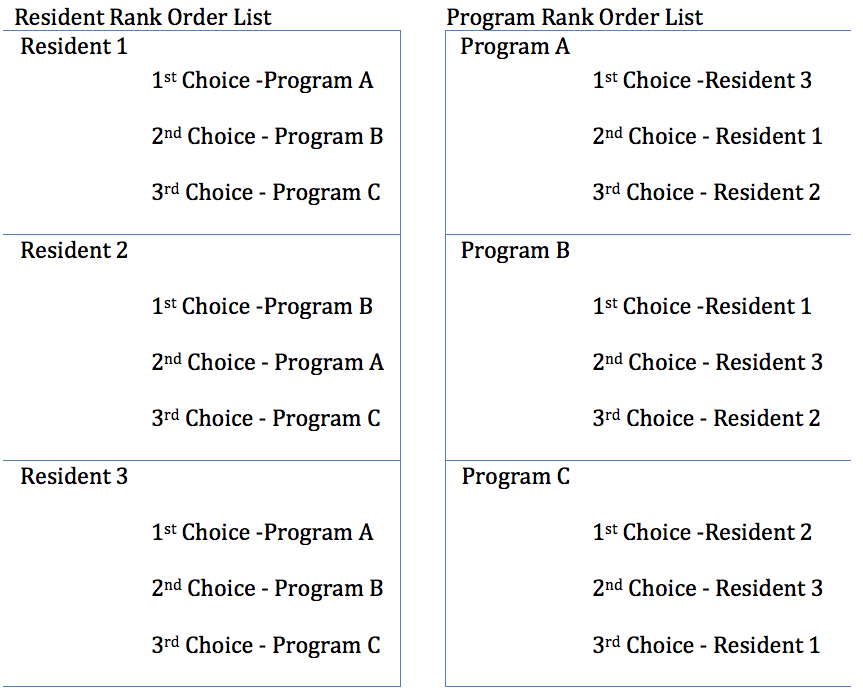
What is the final match result?
Answer:
- Start with Resident 1 by proposing to program A, which is tentatively accepted
- Go to Resident 2. Propose to program B, which is tentatively accepted
- Go to Resident 3. Propose to Program A. As Resident 3 is ranked higher than Resident 1, Resident 3 is tentatively accepted by Program A, and Resident 1 is displaced
- Go to Resident 1. Propose to Program B. As Resident 1 is ranked higher than Resident 2, Resident 1 is tentatively accepted by Program B, and Resident 2 is displaced
- Go to Resident 2. Propose to Program C, which is tentatively accepted
- Final Match Result: Resident 1 – Program B; Resident 2 – Program C; Resident 3 – Program A
QUESTION 4
Somewhat similar to example 3. Three residents, three programs, Resident 3 really would like A, but feels she has a better chance of getting into C. So, Resident 3 ranks C higher than A, going against the true preference strategy.
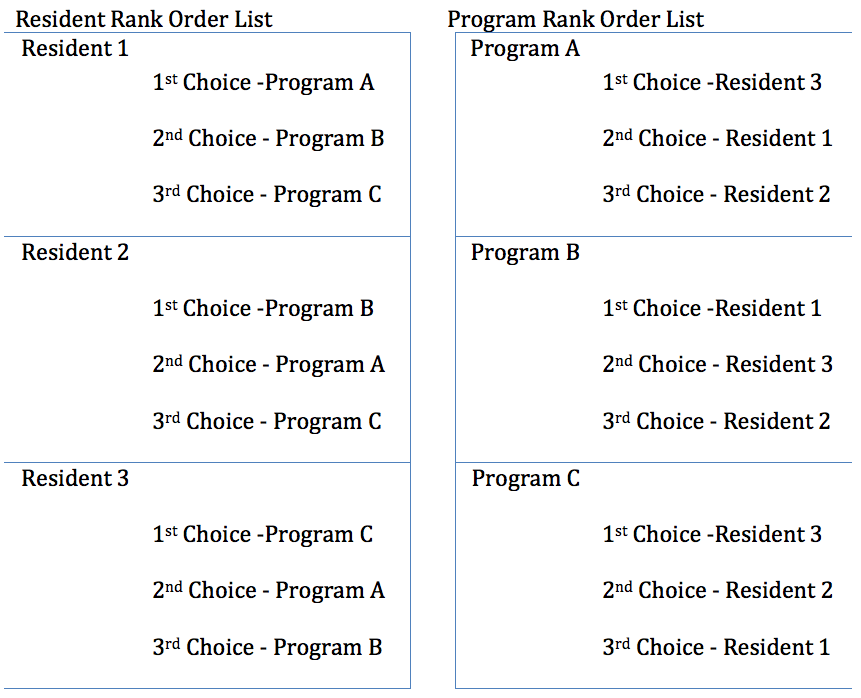
What is the final match result?
Answer:
- Start with Resident 1 by proposing to program A, which is tentatively accepted
- Go to Resident 2. Propose to program B, which is tentatively accepted
- Go to Resident 3. Propose to Program C, which is tentatively accepted
- Final Match Result: Resident 1 – Program A; Resident 2 – Program B; Resident 3 – Program C
Learning point: If Resident 3 would have stuck to her true preferences, she would have been accepted by A. Residents should always order their rank list based ONLY on their own preferences.
QUESTION 5
Three residents, three programs, program C really doesn’t want to take Resident 3, but decides to rank her anyway just in case.
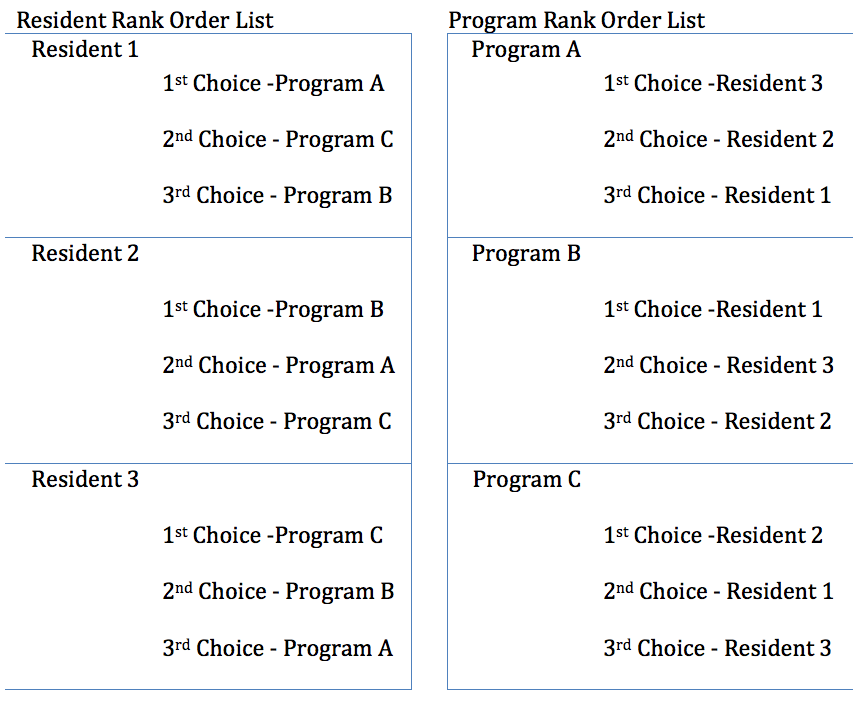
What is the final match result?
Answer:
- Start with Resident 1 by proposing to program A, which is tentatively accepted
- Go to Resident 2. Propose to program B, which is tentatively accepted
- Go to Resident 3. Propose to Program C, which is tentatively accepted
- Final Match Result: Resident 1 – Program A; Resident 2 – Program B; Resident 3 – Program C
QUESTION 5 Extra Credit
Extra Credit: What would happen if program C didn’t rank Resident 3
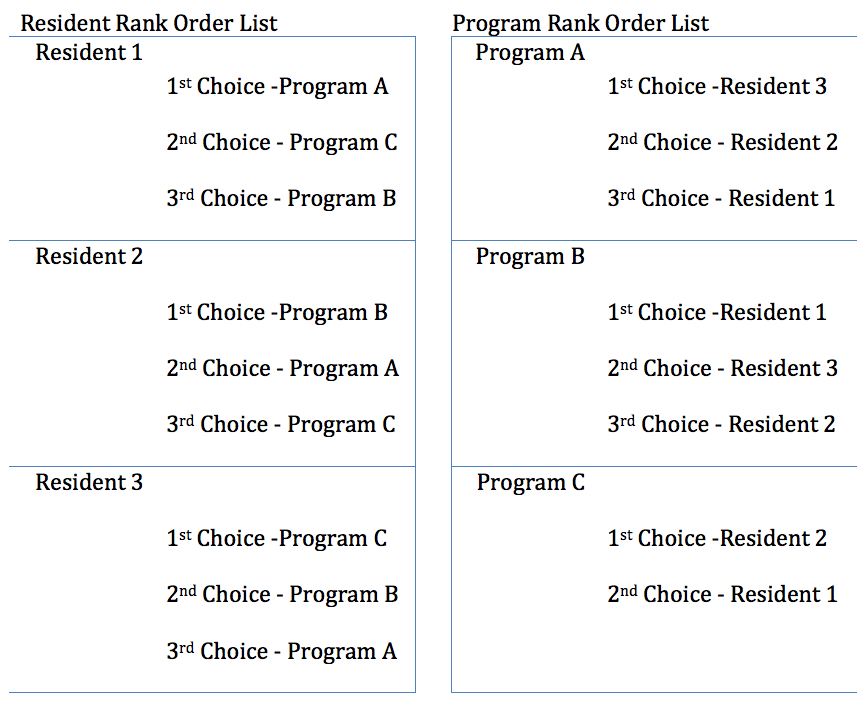
What is the final match result?
Answer:
- Start with Resident 1 by proposing to program A, which is tentatively accepted
- Go to Resident 2. Propose to program B, which is tentatively accepted
- Go to Resident 3. Propose to Program C, which is rejected. Next, propose to program B. As Resident 3 is ranked higher than Resident 2, Resident 3 is tentatively accepted by Program B, and Resident 2 is displaced
- Go to Resident 2. Propose to Program A. As Resident 2 is ranked higher than Resident 1, Resident 2 is tentatively accepted by Program A, and Resident 1 is displaced
- Go to Resident 1. Propose to Program C, which is tentatively accepted
- Final Match Result: Resident 1 – Program C; Resident 2 – Program A; Resident 3 – Program B
Learning Point: If the stars align perfectly, there is a very small benefit of a truncated list for programs (in real life, this happens very rarely). However, programs don’t have enough information prior to submitting their match results to take advantage of this in a systematic way. This though is never true for residents – it is always best to put your true preferences in as your rank order lists.
QUESTION 6
Three residents, four programs (getting a little closer to geriatrics now). However, Program A likes Resident 1 but would like to truncate their list for the very, very small chance of getting better results (see example 5). They decide to remove Resident 1 from their rank.
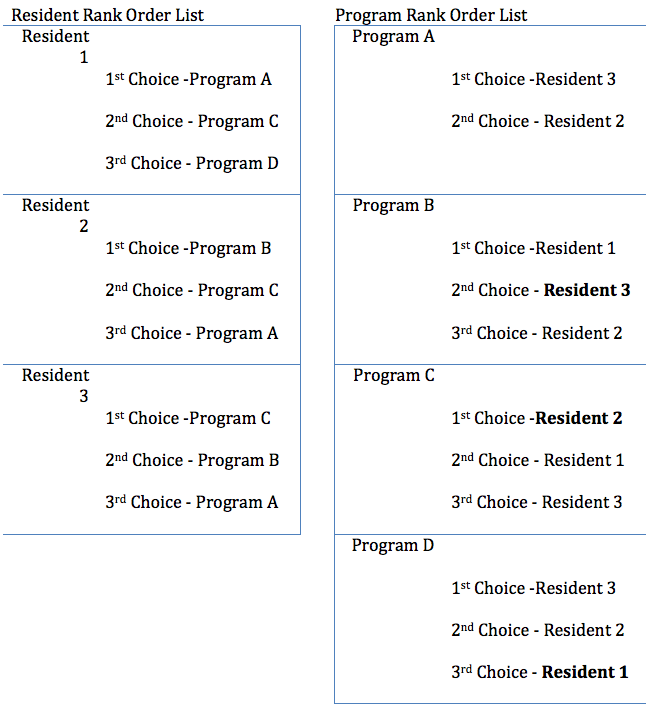
What is the final match result?
Answer:
- Start with Resident 1 by proposing to program A, which is rejected as a didn’t rank Resident 1
- Propose Resident 1 to Program C, which is tentatively accepted
- Go to Resident 2. Propose to program B, which is tentatively accepted
- Go to Resident 3. Propose to Program C, which is rejected. Next, propose to program B. As Resident 3 is ranked higher than Resident 2, Resident 3 is tentatively accepted by Program B, and Resident 2 is displaced
- Go to Resident 2. Propose to Program C. As Resident 2 is ranked higher than Resident 1, Resident 2 is tentatively accepted by Program A, and Resident 1 is displaced
- Go to Resident 1. Propose to Program D, which is tentatively accepted
- Final Match Result: Resident 1 – Program D; Resident 2 – Program C; Resident 3 – Program B
Learning Point: If program A listed Resident 1, they would have matched together. Truncated Rank Order Lists for programs (not for applicants) may slightly improve final assignments but also significantly increases chance of not matching, and the only way to guess right is know exactly what everyone else is putting in as their rank order lists.

That’s all, but read the following for more on the Match:
- The Fellowship Match: Geriatrics Is In, Palliative Care is Still Out
- Matchless: Residents Left in the Lurch
- The Match is Moving Leaving Geriatrics and Palliative Care Behind
by: Eric Widera (@ewidera)



